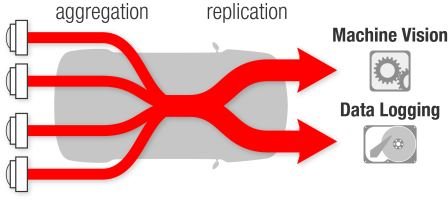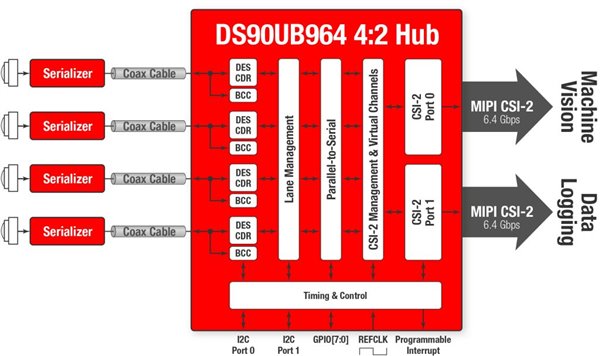SSZTAR4 october 2016 DS90UB964-Q1
As advanced driver assistance systems (ADAS) lead to autonomous driving, there’s an increasing need for multiple copies of aggregated video sensor data for machine vision, viewing, parallel processing and data logging.
The need for multiple copies is especially true for forward-looking machine vision cameras, but it will soon apply to additional cameras, radar and light detection and ranging (LIDAR) sensors in autonomous vehicles. A very common application for replication today is data logging (Figure 1). In machine-vision applications, it is common to record raw sensor data about certain driving events for future analysis. In such cases, it’s useful to have a second copy of the aggregated raw sensor data for data recording, while the other copy is used for machine-vision processing.
 Figure 1 A Common ADAS Data-logging
Topology
Figure 1 A Common ADAS Data-logging
TopologyReplicating Aggregated Sensor Data
 Figure 2 Port-replication Mode Is Useful for Duplicating Aggregated Sensor Data Streams for Machine-vision Processing and Data-logging Operations
Figure 2 Port-replication Mode Is Useful for Duplicating Aggregated Sensor Data Streams for Machine-vision Processing and Data-logging OperationsFigure 3 shows a four-camera system, with different data rates shown by the colored blocks. The aggregated data is presented at both the mobile industry processor interface (MIPI) camera serial interface (CSI)-2 ports 0 and 1. The CSI-2 bus is “bursty,” meaning that it operates at a fixed data rate, blasts data as available and reverts to a low-power (LP) state when idle. Thus, the sensor speed can vary without changing ECU processor timing. Even though the sensor links are running at independent frequencies, the deserializer hub presents data to the system-on-chip (SoC) processor on a single reference clock, simplifying system timing.
 Figure 3 The DS90UB964-Q1 Aggregates and Replicates Four Sensors of Differing Types to Two MIPI CSI-2 Ports
Figure 3 The DS90UB964-Q1 Aggregates and Replicates Four Sensors of Differing Types to Two MIPI CSI-2 PortsThe DS90UB964-Q1 supports MIPI CSI-2 virtual channel ID remapping. Virtual channels separate sensor data in the aggregated stream so that the processor can easily determine which packet comes from which sensor instead of having to count bits in bit-stuffing approaches. The processor simply reads the virtual ID (VC-ID) field in the header to determine the virtual channel address. If the sensors already use identical VC-IDs, they can be remapped to unused VC-IDs to distinguish the incoming data. With up to 1.6Gbps/lane, a total of 6.4Gbps bandwidth per port is available to support four +1MP/60 fps, 2MP/30fps or satellite radar sensors – or a combination of different sensors.
Conclusion
Additional Resources
- Check out the industry's first dual-port MIPI CSI-2 quad deserializer hub with replication mode.
- To get started quickly on your design, download the TI Designs “Automotive ADAS 4 Camera Hub Reference Design with Integrated ISP and DVP Outputs.”
- Pair our deserializer hub with the TDA3x SoC processor for ADAS.
- Learn more about TI’s ADAS solutions.